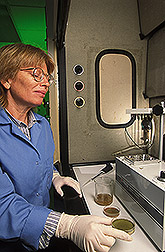Livestock producers should be aware of aflatoxin in corn grain, silage
Posted on Oct 16, 2012

“Aflatoxin can be very toxic and carcinogenic,” said Donna Amaral-Phillips, University of Kentucky College of Agriculture dairy specialist. “The Food and Drug Administration limits the amount of aflatoxin allowable in lactating dairy cow feed to 20 parts per billion and 0.5 parts per billion in milk. These amounts are lower than what is allowed in diets of breeding beef cattle.”
She said that requirements are stricter because 1 to 3 percent of the alflatoxin in the diet of lactating dairy cows can come through in their milk.
Milk is routinely tested for aflatoxin. Amaral-Phillips said if milk has aflatoxin M1 above 0.5 parts per billion, it will not be sold for human consumption.
“The farm with the violation will not be able to sell milk until it tests below 0.5 parts per billion,” she said. “In research trials, aflatoxin appeared in milk within hours of consumption and then returned to a baseline within two to three days. At the farm level, when aflatoxin is detected in milk, the difficulty is often finding its source in the diet, removing it and waiting to be retested.”
“Aspergillus ear rot is a fungal disease resulting in olive-green, powdery mold, generally on the tip of the ear, but it may be located all the way to the base,” said Paul Vincelli, UK extension plant pathologist. “It is caused by Aspergillus flavus, and it can produce aflatoxin, but it doesn’t always do so. The pathogen tends to attach to kernels when temperatures are between 80 and 100 degrees Fahrenheit, in high humidity and high nighttime temperatures during grain fill and pollination.”
The conditions Vincelli described fit Kentucky’s weather pattern this past July and August.
“This doesn’t mean that Kentucky corn does or does not contain aflatoxin,” he said. “It just means that it’s possible.”
Aspergillus flavus gets under the husks by growing on the yellow-brown silks.
If growers have seen mold growing on ears of corn, it doesn’t necessarily indicate alfatoxin is present. Aflatoxin is only one of the hundreds of mycotoxins mold produces.
“Researchers who study Aspergillus ear rot report that kernel development is needed for the growth of Aspergillus mold,” said Chad Lee, UK extension grain crops specialist. “Thus, in corn plants which did not pollinate—harvested as corn silage without ears—the risk for aflatoxin appears to be low.”
Lee recommends that producers should scout for this disease prior to harvesting grain or silage to assess the possibility of potential aflatoxin problems. For more information on detecting this mold, please refer to the UK Grain Crops Update, “Scouting Corn for Aspergillus Ear Rot,” available at http://graincrops.blogspot.com/2012/09/scouting-corn-for-aspergillus-ear-rot.html.
Vincelli and Lee said tests are available for detecting aflatoxin in grain crops; however, they are costly and require proper conditions and accurate sampling.
“Corn silage with corn grain potentially could be a source of aflatoxin and might be a factor in contributing greater than 20 parts per billion in the total diets for dairy cows,” Lee said. “Corn silage harvested from plants without ears carries a low risk. We recommend scouting fields ahead of harvest, but if you’ve already harvested, you may want to test for aflatoxin in well-eared silage. You have to realize you are testing for very low quantities of aflatoxin, and that aflatoxin may not be uniform across the field. When sampling, you may or may not sample the location where the aflatoxin is present. Unfortunately, there are no good solutions here.”
Producers should also be aware that distiller’s grains or corn gluten feed can contain even higher levels of aflatoxin than the corn grain from which they originated.
The state recently received approval for Kentucky corn high in aflatoxin to be mixed with other corn to obtain an aflatoxin content safe for feeding to specific animals.
UK Division of Regulatory Services director Darrell Johnson emphasized, however, that does not make it appropriate for all livestock.
“Producers should understand that they cannot feed the blended product to dairy animals or young swine and beef cattle,” he said. “If you buy the blended product, you’ll have to sign a statement from the seller that you will not feed it to those animals.”
When purchasing blended corn grain, producers should follow the directions in the precautionary statements accompanying the load if they plan to use it in rations for older beef cattle, swine or poultry.
Source: University of Kentucky College of Agriculture
Tagged Post Topics Include: Aflatoxin, Chad Lee, College of Agriculture, Corn, Cow, Darrell Johnson, Donna Amaral-Phillips, FDA, Paul Vincelli, University of Kentucky
Comments